In December 2009 the shop was built, and finish work started in March 2010. First the pictures, then comments.
The concrete pour and concrete finishing. I hired a local mason for this work.
Next the pex install and radiant install. Again, I hired a local professional to do this for me.
The shop was then ready for the boiler and moving the 1000 gal storage tank. The LP gas company from whom I bought the tank moved it for free – a 1-1/2 mile trip from my old shop. The mason moved the boiler for me.
I neighbor who is a welder by trade welded into the tank 2 - 2" fittings. A darn good job.
My plumbing design is to have the boiler feed the tank directly, with 1-1/4" boiler lines going to the new 2" fittings. The top supply fitting has a 1-1/4" pipe on the inside extending 18" horizontally just below the top of the tank. The bottom fitting is for boiler return. Past experience is that the hot water from the boiler stays at the top of the tank, gradually moving down as the whole tank is loaded with hot water. Right now I have a Taco 007 on this very short boiler/tank loop, and I will wait and see how well it handles boiler output as tank temperature climbs above 170F on its way to 190F.
The radiant floor supply draws from the top of the tank and returns via a dip tube to the bottom of the tank. These fittings are 1" and are about 6 feet from the supply/return end of the tank. The supply goes to Side A of a plate heat exchanger and is isolated from Side B for the in-floor pex. I have a Taco 007 on this short loop.
The Side B in-floor pex side of the heat exchanger has anti-freeze, thus the reason for the plate heat exchanger. Six loops of pex, each about 270' of 1/2" pex, 1600 feet total. The shop floor is 32' x 48'. I have a Taco 009 on the Side B in-floor pex side of the heat exchanger.
I also stubbed out fittings to add a unit heater to give a heat boost when needed. I have the unit heater, but have not yet installed it. And stubs out for the over-heat loop which will be installed on the wall above the tank.
The tank is boxed in with 2" foam on the perimeter and stuffed with fiberglass; about R30 all the way around.
There is a 4 foot wide rear access door in the building to bring wood in to keep the Tarm doing its job. I have cleared space behind the building to store 10-20 cords of wood. My guess right now is that I will use about 4 cords each winter of mixed pine, aspen and some birch.
Still to do: install the chimney and the overheat loop, and finish the monitor/control system.
The control system will be quite simple. Basically an aquastat or equivalent to control the boiler circulator: ON at boiler supply of 165F, off at 160F. The Tarm itself shuts down at about 190F, back on at about 180F. The sole purpose of the boiler is to bring the 1000 gal tank up to about 190F and then “rest,” while the radiant floor gets its 120F water via a mixing valve. I will have about 575,000 stored BTU’s if I bring the entire tank up to 190F.
A similar control for the radiant floor. I placed a pex stub into the concrete to take a sensor to control the floor heat. I will have to experiment a bit to see what the best floor temperature should be, maybe 55 - 60F? Maybe an outdoor reset controller? When the radiant floor is ON, the circs on each side of the heat exchanger will be ON. I likely will use a line voltage thermostat for the unit heater to provide a heat boost when and if needed.
I also will be adding a number of sensors to provide interesting data logging and keep me busy during the long, cold, dark Minnesota winter nights, as well as submitting posts to Hearth.com to bother all of you. Sensors for the boiler HWS, boiler HWR, boiler stack; sides A and B of the heat exchanger; unit heater HWS and HWR; tank top, 1/3 down from top, 2/3 down from top, and tank bottom; floor temperature; building inside temperature and outside temperature. Many of these sensors also will feed digital panel meters so at a glance I can get a read-out of total system status.
It would have been great to also have flow meters on the boiler loop, tank loop, and floor loop, but the extra plumbing and cost, as well as added pump head, ruled these out. Flow meters along with delta-T would give accurate BTUH performance data. Now I will have to calculate BTUH performance the old fashioned way.
The concrete pour and concrete finishing. I hired a local mason for this work.
Next the pex install and radiant install. Again, I hired a local professional to do this for me.
The shop was then ready for the boiler and moving the 1000 gal storage tank. The LP gas company from whom I bought the tank moved it for free – a 1-1/2 mile trip from my old shop. The mason moved the boiler for me.
I neighbor who is a welder by trade welded into the tank 2 - 2" fittings. A darn good job.
My plumbing design is to have the boiler feed the tank directly, with 1-1/4" boiler lines going to the new 2" fittings. The top supply fitting has a 1-1/4" pipe on the inside extending 18" horizontally just below the top of the tank. The bottom fitting is for boiler return. Past experience is that the hot water from the boiler stays at the top of the tank, gradually moving down as the whole tank is loaded with hot water. Right now I have a Taco 007 on this very short boiler/tank loop, and I will wait and see how well it handles boiler output as tank temperature climbs above 170F on its way to 190F.
The radiant floor supply draws from the top of the tank and returns via a dip tube to the bottom of the tank. These fittings are 1" and are about 6 feet from the supply/return end of the tank. The supply goes to Side A of a plate heat exchanger and is isolated from Side B for the in-floor pex. I have a Taco 007 on this short loop.
The Side B in-floor pex side of the heat exchanger has anti-freeze, thus the reason for the plate heat exchanger. Six loops of pex, each about 270' of 1/2" pex, 1600 feet total. The shop floor is 32' x 48'. I have a Taco 009 on the Side B in-floor pex side of the heat exchanger.
I also stubbed out fittings to add a unit heater to give a heat boost when needed. I have the unit heater, but have not yet installed it. And stubs out for the over-heat loop which will be installed on the wall above the tank.
The tank is boxed in with 2" foam on the perimeter and stuffed with fiberglass; about R30 all the way around.
There is a 4 foot wide rear access door in the building to bring wood in to keep the Tarm doing its job. I have cleared space behind the building to store 10-20 cords of wood. My guess right now is that I will use about 4 cords each winter of mixed pine, aspen and some birch.
Still to do: install the chimney and the overheat loop, and finish the monitor/control system.
The control system will be quite simple. Basically an aquastat or equivalent to control the boiler circulator: ON at boiler supply of 165F, off at 160F. The Tarm itself shuts down at about 190F, back on at about 180F. The sole purpose of the boiler is to bring the 1000 gal tank up to about 190F and then “rest,” while the radiant floor gets its 120F water via a mixing valve. I will have about 575,000 stored BTU’s if I bring the entire tank up to 190F.
A similar control for the radiant floor. I placed a pex stub into the concrete to take a sensor to control the floor heat. I will have to experiment a bit to see what the best floor temperature should be, maybe 55 - 60F? Maybe an outdoor reset controller? When the radiant floor is ON, the circs on each side of the heat exchanger will be ON. I likely will use a line voltage thermostat for the unit heater to provide a heat boost when and if needed.
I also will be adding a number of sensors to provide interesting data logging and keep me busy during the long, cold, dark Minnesota winter nights, as well as submitting posts to Hearth.com to bother all of you. Sensors for the boiler HWS, boiler HWR, boiler stack; sides A and B of the heat exchanger; unit heater HWS and HWR; tank top, 1/3 down from top, 2/3 down from top, and tank bottom; floor temperature; building inside temperature and outside temperature. Many of these sensors also will feed digital panel meters so at a glance I can get a read-out of total system status.
It would have been great to also have flow meters on the boiler loop, tank loop, and floor loop, but the extra plumbing and cost, as well as added pump head, ruled these out. Flow meters along with delta-T would give accurate BTUH performance data. Now I will have to calculate BTUH performance the old fashioned way.
Attachments
-
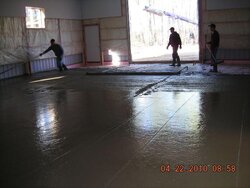 1-Concrete Pour.jpg47.5 KB · Views: 945
1-Concrete Pour.jpg47.5 KB · Views: 945 -
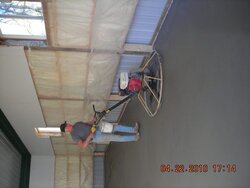 2-Concrete Finish.jpg32.4 KB · Views: 969
2-Concrete Finish.jpg32.4 KB · Views: 969 -
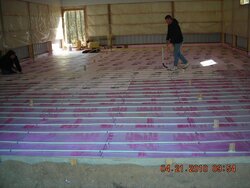 3-Pex Install.jpg50.3 KB · Views: 1,023
3-Pex Install.jpg50.3 KB · Views: 1,023 -
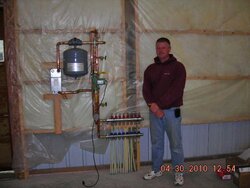 4-Radiant Install-1.jpg42.9 KB · Views: 1,075
4-Radiant Install-1.jpg42.9 KB · Views: 1,075 -
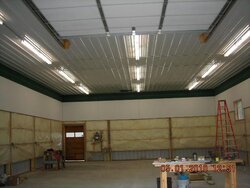 5-Ready for Boiler.jpg44.6 KB · Views: 946
5-Ready for Boiler.jpg44.6 KB · Views: 946 -
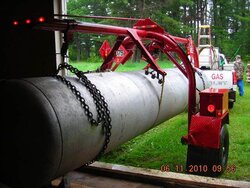 6-Tank Move.jpg65.3 KB · Views: 957
6-Tank Move.jpg65.3 KB · Views: 957 -
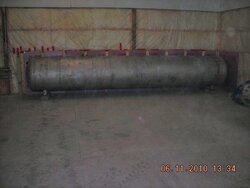 7-Tank in Position-1.jpg28.9 KB · Views: 934
7-Tank in Position-1.jpg28.9 KB · Views: 934 -
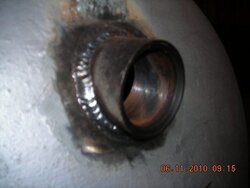 8-Weld Fitting.jpg28.7 KB · Views: 969
8-Weld Fitting.jpg28.7 KB · Views: 969


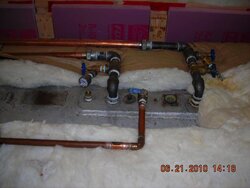
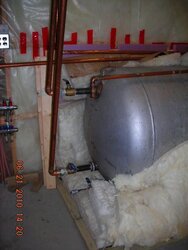
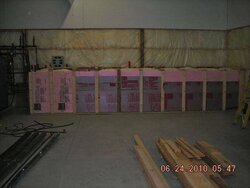
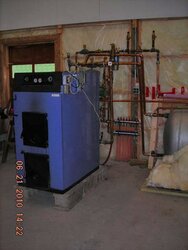
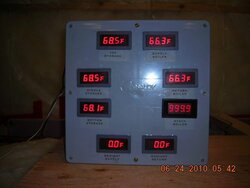
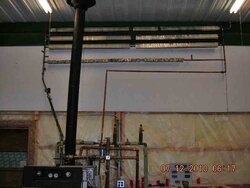
 Just think, no over heat loop along with half of that plumbing, horz. exhaust, Etc. I know, I know, not pressurized. Congrats J, looks like an awesome shop!
Just think, no over heat loop along with half of that plumbing, horz. exhaust, Etc. I know, I know, not pressurized. Congrats J, looks like an awesome shop!